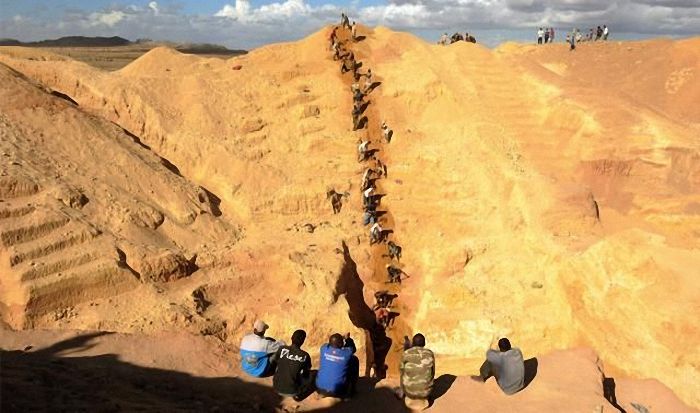|
|
Extraction Of Sapphires, Madagascar
|
• Politics
Although the head of state since March 2009 is self-proclaimed, Madagascar is usually a semi-presidential representative democratic multi-party republic, wherein the popularly elected President is the head of state and selects a Prime Minister to form a government. In the Malagasy system, the word government refers collectively to the President, the Prime Minister and all the heads of government ministries (Ministers), the latter being selected by the Prime Minister but serving at the pleasure of the President. According to the constitution, executive power is exercised by the government while legislative power is vested in both the government and the Senate and the National Assembly, although in reality these two latter bodies have very little power or legislative role. The constitution declares the judiciary to be independent of the executive and the legislature, but constitutional provisions empowering the Minister of Justice to interfere in operations of the judiciary branch effectively undermine intended separation of powers, consolidating the strength of the executive branch.
The political situation in Madagascar has been marked by struggle for control. After Madagascar gained independence from France in 1960, political transitions have been marked by numerous popular protests, several disputed elections, two military coups and one assassination. Didier Ratsiraka took power in a military coup in 1975 and ruled until 2001, with a short break when he was ousted in the early 1990s. When Marc Ravalomanana and Ratsiraka both claimed victory after presidential elections in December 2001, Ratsiraka's supporters tried to blockade the capital, Antananarivo, which was pro-Ravalomanana. After eight months of sporadic violence with considerable economic disruption, a recount in April 2002 led the High Constitutional Court to pronounce Ravalomanana president, but it was not until July that Ratsiraka fled to France and Ravalomanana gained control of the country. Between 2002 and 2009, Ravalomanana and his party Tiako I Madagasikara (TIM) dominated political life. Ravalomanana's re-election in December 2006 was met with some protests over worsening standards of living, despite an ongoing government drive to eradicate poverty.
A series of protests against then-President Marc Ravalomanana in 2009, backed by Andry Rajoelina, former mayor of Antananarivo, became violent, with more than 170 people killed. Rajoelina mobilized his supporters to take to the streets of Antananarivo to demand Ravalomanana's ousting on the grounds of his autocratic style of government. After losing support of the military and under intense pressure from Rajoelina, President Ravalomanana resigned on March 17, 2009. Ravalomanana assigned his powers to a military council loyal to himself headed by Vice-Admiral Hyppolite Ramaroson. The military called the move by Ravalomanana a "ploy" and said that it would support Rajoelina as leader. Rajoelina had already declared himself the new leader a month earlier and assumed the role of acting President, appointing Monja Roindefo as Prime Minister. Rajoelina announced that elections would be held in two years and that the constitution would be amended. The European Union, amongst other international entities, refused to recognize the new government, due to it being installed by force. The African Union, which proceeded to suspend Madagascar's membership on March 20, and the Southern Africa Development Community both criticized the forced resignation of Ravalomanana.
|
|









